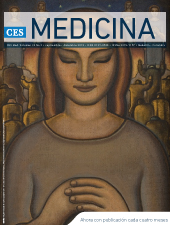Espasticidad como signo positivo de daño de motoneurona superior y su importancia en rehabilitación
DOI:
https://doi.org/10.21615/cesmedicina.32.3.7Resumo
Introducción: la espasticidad, como signo clínico de daño de motoneurona superior, cobra gran importancia al momento de definir su impacto en el proceso rehabilitador. Los objetivos de esta revisión bibliográfica son: analizar la evolución de la espasticidad como concepto, describir los hallazgos actuales en relación con su fisiopatología y analizar su importancia en el proceso rehabilitador.
Métodos: búsqueda bibliográfica durante el segundo semestre del 2017 en bases de datos Pubmed, Scielo, Cochrane y Google Académico, utilizando los términos MeSH: muscle spasticity, physiopathology y stroke. Los límites de búsqueda fueron: textos completos en idioma inglés y español, en humanos y publicados durante los últimos cinco años.
Resultados: la fisiopatología de la espasticidad no es causada por un solo mecanismo, sino más bien una intrincada cadena de alteraciones en diferentes redes nerviosas interdependientes. Existiendo dos mecanismos principales: la alteración del control espinal y suprasegmentario y los cambios en las propiedades del sistema músculo-esquelético.
Conclusión: la evidencia científica es amplia y aborda el concepto de espasticidad, sus implicancias fisiopatológicas y clínicas. Sin embargo, futuras investigaciones deberían orientar y apoyar las decisiones del equipo rehabilitador, en relación con el manejo clínico.
Downloads
Referências
Balbosh Am Kern M. Effect of surface treatment on retention of glass fiber endodontic
post. Journal of Prosthetic Dentistry. 2006; 95(3):218-223. link
Baraban D. The restoration of endodontically treated teeth: an update. J Prosthed
Dent. 1988; 59(5):553-558. link
Schiavetti R, García F, Toledano M , Mazzitelli C, Barlattani A, Ferrari M, Comparison
of fracture resistance of bonded glass fiber posts at different lengths. Am J
Dent. 2010; 23(4):227-230. link
Plotino G, Grande N, Bedini R, Pameijer C, Somma F. Flexural properties of endodontic
posts and human root dentin. Dental Materials.2007. 23(9):1129-1135. link
Morgano S, Brackett S. Foundation restorations in fixed prosthodontics: current
knowledge and future needs- J Prosthet Dent. 1999; 82(6):643-657. link
Schmitter M, Hamadi K, Rammelsberg P- Survival of two post systems-five-year results
of a randomized clinical trial. Quintessence International. 2011; 42(10):843-850.
link
Goracci C, Ferrari M. Current perspectives on post systems: a literature review.
Australian Dental Journal. 2011; 56(Suppl1):77-83. link
Goodacre C, Spolnil K. The prosthodontic management of endodontically treated
teeth: a literature review. Part I. Success and failure data, treatment concepts. J
Proshtodont. 1994; 3(4):243-250. link
Breschi L, Mazzoni A, Ferrari M. Adhesion to intra radicular dentin en: Ferrari
M. Fiber posts and endodontically treated teeth: a compendium of scientific and
clinical perspectives. Wendywood: Moderns Dentistry Media, 2008(1):15-37.
Mamootil K, Messer H. Penetration of dentinal tubules by endodontic sealer cements
in extracted teeth and in vivo. Int Endod J. 2007; 40(11):873-881. link
Saupe W, Glusking A, Radke R. A comparative study of fracture resistance between
morphologic dowel and cores and a resin reinforced dowel system in the
intraradicular restoration of structurally compromised roots. Quintessence Int.
; 27(7):483-491. link
Stern N, Hirshfeld Z. Principles of preparing endodontically treated teeth for
dowel and core restorations. J Prosthet dent. 1973(2); 30:162-165. link
Vichi A, Ferrari M, Davidson C. Influence of ceramic and cement thickness on the
masking of various types of opaque posts. J Prosthet Dent. 2000; 83(4):412-417. link
Toksavul S, Toman M, Uylgan B, Schmage P, Nergiz I. Effect of luting agents and
reconstruction techniques on the fracture resistance of pre-fabricated post systems.
Journal of Oral Rehabilitation.2005; 32(6):433-440. link
Giovani A, Vansan L, de Sousaneto M, Paulino S. In vitro fracture resistance of
glass-fiber and cast metal posts with different lengths. J Prosthet Dent. 2009;
(3):183-188. link
Parisi C, Valandro L, Ciocca L, Gatto M, Baldissara P. Clinical outcomes and success
rates of quartz fiber post restorations: A retrospective study. The Journal
of Prosthetic dentistry. 2015; 114(3): 367-372. link
Fernandes A, Dessai G. Factors affecting the fracture resistance of post-core
reconstructed teeth: a review. Int J Prosthodont. 2001; 14(4):355-363. link
Schwartz R. Fundamentals of operative dentistry.1 ed. Londres. Quintessense
Publishing. 1996:. p325. link
Nasr H, Eskander M, Zaki A. The luting efficacy of cement in bonding dowels of
different metal. Egypt dent J. 1987; 33(2):155-171. link
Tjan A, Tjan A, Greive J. Effects of various cementation methods on the retention
of prefabricated post. J Prosthet Dent. 1987; 58(3):309-311. link
Hochman N, Feinzaig I, Zalkind M. Effect of design of pre-fabricated post and
post heads on the retention of various cements and core materials. J Oral Rehabil.
; 30(7): 702-707. link
Zhou L. Wang Q. Comparison of fracture resistance between cast posts and
fiber posts: a metanalysis of literature. J Endod. 2013. 39(1):11-15. link
Polly M, Nicholls J, Junge T, Phillips K. Load fatigue of teeth with different ferrule
lengths, restored with fiber posts, composite resin cores, and all ceramic
crowns. J Prosthet Dent. 2009; 102(4):229-234. link
Berastain Jm Domínguez E y Pagan L. Diagnóstico y tratamiento de la oclusión.
En: Odontología Integral Actualizada. Brasil: 2006. Editorial Artes Médicas Ltda,
p64-65.
Verissimo C, Simamoto P, Soares C, Noritomi P, Freita P. Effect of the crown post
and remaining coronal dentin on the biomechanical behavior of endodontically
treated maxillary central incisors. J Prosthet Dent 2014; 111(3):234-246. link
Chan R. Restoration of endodontically treated teeth. Aust Prosthodont J. 1988;
(1):55-66.
Fernandes A, Shetty S, Coutihho . Factors determining post selection; a literature
review- J Prosthet Dent. 2003; 90(6):556-562. link
Dikbas I, Tanalp J. An overview of clinical studies on fiber post systems. The
Scientific world Journal. 2013; Article ID 171380. doi:10.1155/2013/171380.
Vire D. Failure of endodontically treated teeth: Classification and evaluation. J
Endod. 1991; 17(7):338-342. link
Chang J, Soo I, Cheung G. Evaluation of fiber post-supported restorations under
simulated occlusal loading. J Prosthet Dent. 2012; 108(3):158-164. link
Al-Harbi F, Nathanson D. In vitro assesment of retention of four esthetic dowels
to resin core foundation and teeth J Prosthet Dent. 2003; 90(6):547-555. link
Pedro.org.au [Internet].Australia; Australian Physiotherapy Asociation; 2016 [actualizado
de mayo de 2016; citado 8 feb 2016]. Disponible en: http://www.pedro.
org.au/wp-content/uploads/PEDro_scale_spanish.pdf.
Chuang S, Yaman P, Herrero A, Dennison J, Chan C. Influence of post material and
length on endodontically treated incisors: An in vitro and finite element study. J
Prosthet Dent. 2010; 104(6):379-388. link
Maroulakos G, Nagy W, Kontogiorgos E. Fracture resistance of compromised endodontically
treated teeth restored with bonded post and cores: An in vitro study.
The Journal of Prosthetic Dentistry. 2015; 114(3):390-397. link
Varvara G, Perinetti G, Dilorio D, Murmura G, Caputi S. In vitro evaluation of fracture resistance
and failure mode of internally restored endodontically treated maxillary incisors
with differing heights of residual dentin. J Prosthet Dent. 2007; 98(5):365-372. link
Jung S, Min K, Chang S, Park S, Kwon S, Bae J. Microleakage and fracture patterns
of teeth restored with different posts under dynamic loading. J Prosthet
Dent. 2007; 98(4):270-276. link
Hyedecke G, Peters M. The restoration of endodontically treated, single rooted
teeth with cast or direct posts and cores: A systematic review. J Prosthet Dent.
; 87(2):380-386. link
Mattison G, Delivanis P, Thacker R, Hassel K. Effect of post preparation on the
apical seal. J Prosthet Dent. 1984; 51(6):785-589. link
Pereira J, Ornelas F, Rodríguez P, Lins A. Effect of a crown ferrule on the fracture
resistance of endodontically treated teeth restored with prefabricated posts. The
journal of prosthetic dentistry. 2006; 95(1):50-54. link
Gegauff A. Effect of crown lengthering and ferrule placement on static load failure
of cementes cast post cores and crowns. J Prosthet Dent. 2000; 84(2):169-
link
Trabert K, Caputo A. Abou Rass M. Tooth fracture a comparison of endodontic and
restorative treatments. J endod. 1978; 4(11):341-345. link
Maceri F, Martignoni M, Vairo G Mechanical behaviour of endodontic restorations
with multiple prefabricated posts: A finite element approach. . Journal of Biomechanics.
; 40(11):2386-2398. link
Dilmener F, Sipahi C, Dalkiz M. Resistance of three new esthetic post and core
systems to compressive loading. J Prosthet Dent. 2006; 95(2):130-136. link
Stern N, Hirshfeld Z. Principles of preparing endodontically treated teeth for
dowel and core restorations. J Prosthet dent. 1973; 30(2):162-165. link
Monga P, Sharma V, Kunar S. Comparison of fracture resistance of endodontically
treated teeth using different coronal restorative materials: an in vitro study.
Journal of Conservative Dentistry. 2009; 12(4):154-159. link
Belli S, Erdemir A, Yildirim C. Reinforcement effect of polyethylene fibre in rootfilled
teeth: comparison of two restoration techniques. International Endodontic
Journal. 2006; 39(2):136-142. link
Dikbas I, Tanalp J, Ozel E, Koksal T. Ersot M. Evaluation of the effect of different
ferrule designs on the fracture resistance of endodontically treated maxillary
central incisor incorporating fiber posts, composite cores and cros restorations.
Journal of Contemporary Dental Practice. 2007; 8(7):62-69. link
Vire D. Failure of endodontically treated teeth: Classification and evaluation. J
Endod. 1991; 17(7):338-342. link
Amarnath G, Swetha M, MuddugangadharB, Sonika R, Garg A, Rao T. Effect of
post material and length on fracture resistance of endodontically treated premolar:
A in vitro study. Journal of international Oral health. 2015; 7(7):22-28. link
Monticelli F, Osorio R, Sadek F, Radovic I, Toledano M, Ferrari M. Surface
treatments for improving bond strength to prefabricated fiber posts: A literature
Review. Operative Dentistry. 2008; 33(3):346-355. link
Downloads
Publicado
Como Citar
Edição
Seção
Licença

Este trabalho está licenciado sob uma licença Creative Commons Attribution-NonCommercial-ShareAlike 4.0 International License.
Derechos de reproducción (copyright)
Cada manuscrito se acompañará de una declaración en la que se especifique que los materiales son inéditos, que no han sido publicados anteriormente en formato impreso o electrónico y que no se presentarán a ningún otro medio antes de conocer la decisión de la revista. En todo caso, cualquier publicación anterior, sea en forma impresa o electrónica, deberá darse a conocer a la redacción por escrito.
Plagios, duplicaciones totales o parciales, traduccones del original a otro idioma son de responsabilidad exclusiva de los autores el envío.
Los autores adjuntarán una declaración firmada indicando que, si el manuscrito se acepta para su publicación, los derechos de reproducción son propiedad exclusiva de la Revista CES Medicina.
Se solicita a los autores que proporcionen la información completa acerca de cualquier beca o subvención recibida de una entidad comercial u otro grupo con intereses privados, u otro organismo, para costear parcial o totalmente el trabajo en que se basa el artículo.
Los autores tienen la responsabilidad de obtener los permisos necesarios para reproducir cualquier material protegido por derechos de reproducción. El manuscrito se acompañará de la carta original que otorgue ese permiso y en ella debe especificarse con exactitud el número del cuadro o figura o el texto exacto que se citará y cómo se usará, así como la referencia bibliográfica completa.



